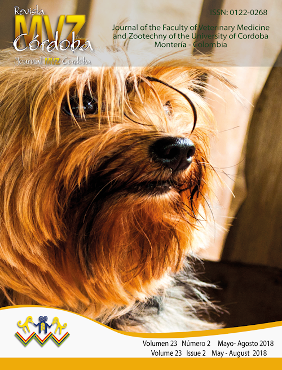Bacterias endófitas promotoras de crecimiento aisladas de pasto colosoana, departamento de Sucre, Colombia
Endophytes bacterial growth promoters isolated to colosoana grass, Department of Sucre, Colombia
Mostrar biografía de los autores
Objetivo. Evaluar in vitro la eficiencia de las bacterias endófitas promotoras de crecimiento aisladas de diferentes tejidos de pasto colosuana en el municipio de Corozal, departamento de Sucre, Colombia. Materiales y métodos. Se aislaron bacterias endófitas, se determinó densidad poblacional en UFC/g de tejido, seguidamente se llevó a cabo pruebas cuantitativas y cualitativas de las actividades de FBN, solubilización de fosfatos, producción de sideróforos y de AIA para finalmente se realizó identificación por secuenciamiento de las aquellas bacterias que tuvieron actividad positiva de promoción de crecimiento. Resultados. Las mayores poblaciones fueron encontradas en raíces (5.0 X 1010 3.8 X 1010 2.8 X 1010 2.4 X 1010 y 1.5 X1010 UFC/g de tejido, para los corregimientos de La Peñas, El Mamón, Cantagallo, Chapinero y Hato Nuevo, respectivamente) con respecto a tallo y hoja. Un total de 53 bacterias endófitas aisladas, 18 mostraron capacidad reductora de N2 a amonio; 15 morfotipos mostraron capacidad solubilizadora de fosfatos; 8 de producción de ácido indol acético y 12 de productoras de sideróforo. Conclusiones. Este trabajo aisló bacterias endófitas con capacidad de promover el crecimiento vegetal. Dos especies de bacterias endófitas fueron identificadas como Delftia tsuruhatensis y Pseudomonas hibiscicola (S. maltophilia), las cuales mostraron excelentes resultados de solubilización de fosfatos, reducen N2 a amonio, producción de ácido índol acético y la producción de sideróforos.
Visitas del artículo 1749 | Visitas PDF
Descargas
- Pérez CR., Vertel MM., Pérez CA. 2015. Effect of different types of fertilizers on soil fungi in the agroecosystem Bothriochloa pertusa (L) A. Camus, in the Sabanas sucre-as, Colombia. Livestock. 27(1) http://www.lrrd.org/lrrd27/1/pere27004.html.
- Gomez C, Mercado J, Payares F, Perez A. Identification of nematodes associated with the grass colosuana (Bothriochloa pertusa (L) A. Camus) in the municipality of Sampués department of Sucre, Colombia. Rev Colombiana Cienc Anim 2010; 2(2):325-330. https://doi.org/10.24188/recia.v2.n2.2010.311
- Cardona E, Rios L, Pe-a J. Availability of Grasses and Forages as Potential Lignocellulosic Materials for Bioethanol Production in Colombia. Technological Information 2012; 23(6):87-96.
- Peters M, Franco T, Schmidt A, Hincapie B. Species forrajeras multiintention: Options for producers of the American Tropic. International Center of Tropical Agriculture (CIAT). 2011. URL disponible en: http://ciat-library.ciat.cgiar.org:8080/jspui/bitstream/123456789/7035/1/Especies_Forrajeras_Multiproposito_2011.pdf
- Pérez A, Rojas J, Fuentes J. Endophytes Bacteria diversity of associated with roots of colosuana (Bothriochloa pertusa) Pasture in three locations of the department Sucre, Colombia. Acta Biol Colomb. 2010; 15(2):219-228
- Lara, C., Avila E.L, Pe-ata, N. Native phosphate solubilizing bacteria to increase the crops in the department of Cordova-Colombia. Rev Bio Agro. 2011; 9(2):114-120.
- Zinniel K, Lambrecht P, Harris B., Feng Z, Kuczmarski D, Higley P, Vidaver A. Isolation and characterization of endophytic colonizing bacteria from agronomic crops and prairie plants. J Appl Environ Microbiol 2002; 68(5):2198-2208. https://doi.org/10.1128/AEM.68.5.2198-2208.2002
- Pérez A, Tuberquia A, Amell D. In vitro activity of nitrogen fixating and phosphate solubilizing bacteria. Agron Mesoam. 2014; 25(2):267-276.
- Barraza Z, Pérez A. Endophytes bacteria promoters of growth associated with varieties of rice of the Colombian Caribe. [Thesis masters in Biotechnology]. University of Córdoba: Montería, Córdoba; 2015.
- Rodriguez H, Fraga R, Gonzalez T, Bashan Y. Genetics of phosphate solubilization and its potential applications for improving plant growth-promoting bacteria. Plant and Soil 2006; 287(1-2):15-21. https://doi.org/10.1007/s11104-006-9056-9
- Lara C, Sanes S, Oviedo L. Impact of native phosphate solubilizing bacteria on the growth and development of radish (Raphanus sativus) plants. Applied Biotechnology 2013; 30(4):276-279.
- Dawwam G, Elbeltagy A, Emara H, Abbas I, Hassan M. Beneficial effect of plant growth promoting bacteria isolated from the roots of potato plant. Ann Agric Sci. 2013; 58(2):195-201. https://doi.org/10.1016/j.aoas.2013.07.007
- Doncel A, Chamorro L, Pérez A. Activity in vitro of bacteria endophytes promoters of growth associated with colosoana pasture in the municipality of Corozal, Sucre. Rev Colombiana Cienc Anim. 2016; 8(Supl):351-360. https://doi.org/10.24188/recia.v8.n0.2016.391
- Oliveira M, Santos T, Vale H, Delvaux J, Cordero A, Ferreira A, Moraes C. A. Endophytic microbial diversity in coffee cherries of Coffea arabica from southeastern Brazil. Can J Microbiol. 2013; 59(4):221-230. https://doi.org/10.1139/cjm-2012-0674
- Tamura K, Stecher G, Peterson D, Filipski A, Kumar S. MEGA 6: molecular evolutionary genetics analysis version 6.0. Mol Biol Evol. 2013; 30(12):2725-2729. https://doi.org/10.1093/molbev/mst197
- Axelrood PE, Chow ML, Radomski CC, Dermot JM, Davies J. Molecular characterization of bacterial diversity from British Columbia forest soils subjected to disturbance. Can J Microbiol. 2002; 48:655-674. https://doi.org/10.1139/w02-059
- Lara C, Villalba M, Oviedo L. Non-symbiotic bacterial diazotrophs from of agricultural crops of San Carlos. Córdoba, Colombia. Rev Colomb Biotecnol. 2007; 9(2):6-14.
- Anzuay MS, Frola O, Angelini JG, Ludue-a LM, Fabra A, Taurian T. Genetic diversity of phosphate-solubilizing peanut (Arachis hypogaea L.) associated bacteria and mechanisms involved in this ability. Symbiosis. 2013; 60(3):143-154. https://doi.org/10.1007/s13199-013-0250-2
- Lara C, Oviedo L, Aleman A. Strain native with potencial in the acetic acid production indol to improve the agriculture. Rev Bio Agro Vol. 2011; 9(1):17-23.
- Zheng YK, Qiao XG, Miao CP, Liu K, Chen YW, Xu LH, Zhao LX. Diversity, distribution and biotechnological potential of endophytic fungi. Ann Microbiol. 2016; 66:529-542. https://doi.org/10.1007/s13213-015-1153-7
- Jasim B, Jimtha CJ, Jyothis M, Radhakrishnan E. Plant growth promoting potential of endophytic bacteria isolated from Piper nigrum. Plant Growth Regulation. 2013; 71(1):1-11. https://doi.org/10.1007/s10725-013-9802-y
- Liu X, Dou G, Ma Y. Potential of endophytes from medicinal plants for biocontrol and plant growth promotion. J Gen Plant Pathol. 2016; 82(3):165-173. https://doi.org/10.1007/s10327-016-0648-9
- Singh RS, Mazumder P. Molecular characterization of endophytic bacteria capable of nitrogen fixation Isolated from Young Parkia Roxburghii Plant Of Manipur, India. IJSRES. 2015; 2(8):91-95
- Liu Y, Zuo S, Zou Y, Wang J, Song W. Investigation on diversity and population succession dynamics of endophytic bacteria from seeds of maize (Zea mays L., Nongda108) at different growth stages. Ann Microbiol 2013; 63(1):71-79. https://doi.org/10.1007/s13213-012-0446-3
- Akinsanya MA, Goh JK, Lim SP, Ting AS. Diversity, antimicrobial and antioxidant activities of culturable bacterial endophytes communities in Aloe vera. FEMS Microbiol Lett. 2015; 362(23):1-8. https://doi.org/10.1093/femsle/fnv184
- Rojas D, Zetter E, Contreras Miguel, Rocha M, Macías L, Santoyo G. Pseudomonas stutzeri E25 and Stenotrophomonas maltophilia CR71 endophytes produce antifungal volatile organic compounds and exhibit additive plant growth-promoting effects. Biocatal Agric Biotechnol. 2018; 13:46–52. https://doi.org/10.1016/j.bcab.2017.11.007
- Sun L, Qiu F, Zhang X, Dai X, Dong X, Song W. Endophytic bacterial diversity in rice (Oryza sativa L.) roots estimated by 16S rDNA sequence analysis. Microb Ecol. 2008; 55(3):415-424. https://doi.org/10.1007/s00248-007-9287-1
- Han J, Sun L, Dong X, Cai Z, Sun X, Yang H, Song W. Characterization of a novel plant growth-promoting bacteria strain Delftia tsuruhatensis HR4 both as a diazotroph and a potential biocontrol agent against various plant pathogens. Syst Appl Microbiol. 2005; 28(1):66-76. https://doi.org/10.1016/j.syapm.2004.09.003
- Ringelberg D, Foley K, Reynolds CM. Bacterial endophyte communities of two wheatgrass varieties following propagation in different growing media. Can J Microbiol. 2012; 58(1):67-80. https://doi.org/10.1139/w11-122
- Wurdig L, Pereira L, Menezes F, Triplett W, Oliveira F. Diversity of diazotrophic endophytic bacteria associated with maize plants. Rev Bras Ciênc Solo. 2007; 31:1367-1380.
























